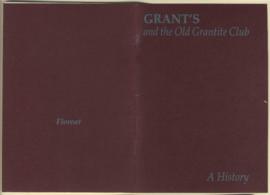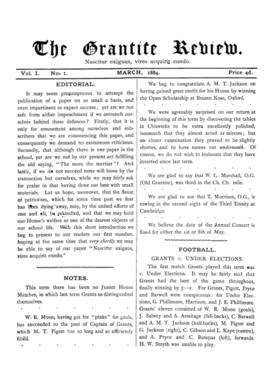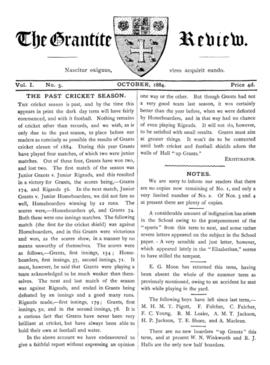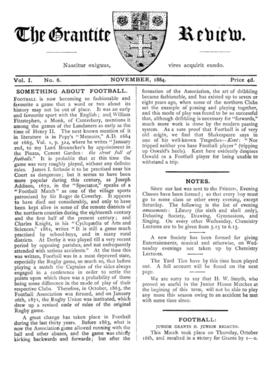Identity area
Reference code
Title
Date(s)
- 1884- (Creation)
Level of description
Extent and medium
15 boxes and 4 ledgers
Context area
Name of creator
Biographical history
Name of creator
Administrative history
Grant's was opened as an independent boarding house by Mrs Margaret Grant, or Mother Grant I, in 1749, when keeping boarders was one of the few respectable occupations for middle-class women. The house continued under the Grants’ management until Mrs Dixon, the last of the family, sold the building to the then housemaster, Charles Alfred Jones in 1868. As well as income from the sale of the house, Mrs Dixon also had a share of the profits of Dixon's antibilious pills, the world-famous 'pill to cure all ills'.
Many traditions survive at Westminster, but one that has been discontinued at Grant’s is the custom that saw new boarders ‘walk the mantelpiece’ in Hall. Lawrence Tanner, a pupil who kept a thorough diary of his time at Westminster, records his own experience of walking the mantelpiece here.
Grantites of particular interest include Lord John Russell (1792-1878), a Whig and Liberal Prime Minister and keen reformist; Charles Longley (1794-1868), Archbishop of Canterbury; Edgar Adrian (1899- 1977), winner of the Nobel Prize for Physiology; the actor John Gielgud (1904-2000) and Dominic Grieve MP (1956-).
Repository
Archival history
Grant's House derives its name from the Grant family, and specifically John Grant and then his wife Mrs Margaret Grant who became a tenant in Little Dean's Yard in 1749 and 'Dame' of the House after her husband died. Like Rigaud's House it can be traced back to Vaughan's House which occupied the site of the present building. In 1765 Mrs Grant moved into the large House on the south side of Little Dean's Yard, originally built in 1789, which is the site of the present Grant's House. The House passed through various members of the Grant family until the Rev. James Marshall was appointed Housemaster in 1847, but retained the name Grant's House. Early members of Grant's House include Lord John Russell, Charles Longley and George Keppel. Another influential member of Grant's House was Lawrence Tanner (G 1905-1909). He was Head of Grant's House (1908-1909) and later president of the 'Old Grantite Club', and a diligent historian of the House. He complied lists of Heads of House and members of the House and worked extensively on preserving the history of Grant's House, writing books on the history of Westminster School, including Westminster School its Buildings and their Associations (1932) and Westminster School: A History (1934).
In 1884 the first edition of the 'Grantite Review' was published which is claimed to be the oldest House magazine in the school.
Alterations to the building were made during the nineteenth century, but the first significant alterations were made in 1921 when a new Hall was made out of the old Chiswicks. During the second world war the House was evacuated three times; first the Lancing, then Exeter and finally to Fernie Bank. Under the Housemaster Mr J. M. Wilson (1948 - 1963) the Hall and adjoining buildings at the back of Grant's house were rebuilt and completed in 1955. The 1960s marked a new era for Grant's House with a change in atmosphere, as authority and rules were questioned. During the 1970s and 1980s the individual character of the House dissipated and gave way to a more general Westminster School character, as the School became more unified. By 1985 boarders at the House were in a minority. Grant's was one of the last Houses to take in female members.
The origins of the 'Old Grantite Club' are not clear but it is thought to have been founded at a meeting of four Old Grantites in 1921. It was a club which alumnus of Grant's House could join, and took on its modern day form in 1926 with the aim of strengthening and promoting the comradeship of Old Grantites through reunions. The club donated money to Grant's House to help with building work and also the publication of the 'Grantite Review'. It also attempted to acquire paintings of the Grant family for the House. In 1981 women were allowed to be elected as members of the Club.
Content and structure area
Scope and content
This collection contains a variety of material relating to Grant's House. There are four House ledgers which record events in the House including details of sports, societies and plays performed by the House. As well as these ledgers there are sports ledgers which record in more detail events such as cricket and football matches. Also in the collection are administrational records which give details of the members of the House, financial accounts of the money received and spent by the House and the rules and customs of the House. A significant part of the collection is composed of the Grant's House magazine 'The Grantite Review' of which there is a comprehensive collection. Another part of the collection concerns the history of Grant's and contains details of pupils and teachers during the nineteenth century. Finally, the collection contains details of the 'Old Grantite Club', a group for alumnus of Grant's House which includes details of members, committee meetings and publications on the history of Grant's House.
Appraisal, destruction and scheduling
Accruals
System of arrangement
The material has been arranged into six subseries; House Ledgers, Administration of Grant's House, Sport, Publications, History of Grant's House and The Old Grantite Club. Material within the 'History of Grant's' series is similar to that within the 'Administration of Grant's House' series, but contains material relating to the nineteenth century which was compiled from secondary sources, rather than contemporary sources, so it has been catalogued separately.
Conditions of access and use area
Conditions governing access
Access to collection items is granted to bona-fide researchers, by prior appointment, subject to the overriding provisions of relevant legislation, including Data Protection.
Conditions governing reproduction
A reprographics service is available to researchers subject to the access restrictions outlined above. Copying will not be undertaken if there is any risk of damage to the item. Copies are supplied in accordance with Westminster School's Policy on Archive and Heritage Collections, and under provisions of any relevant copyright legislation. Permission to reproduce images of items in the custody of Westminster School must be sought from its Governing Body.
Language of material
- English
Script of material
- Latin
Language and script notes
Physical characteristics and technical requirements
Finding aids
Allied materials area
Existence and location of originals
Existence and location of copies
Related units of description
Alternative identifier(s)
Access points
Subject access points
Place access points
Name access points
Genre access points
Description control area
Description identifier
Institution identifier
Rules and/or conventions used
Status
Level of detail
Language(s)
Script(s)
Sources
Archivist's note
This catalogue was prepared by Emma Down, student at UCL, at Westminster School Archive, April-May 2013.










